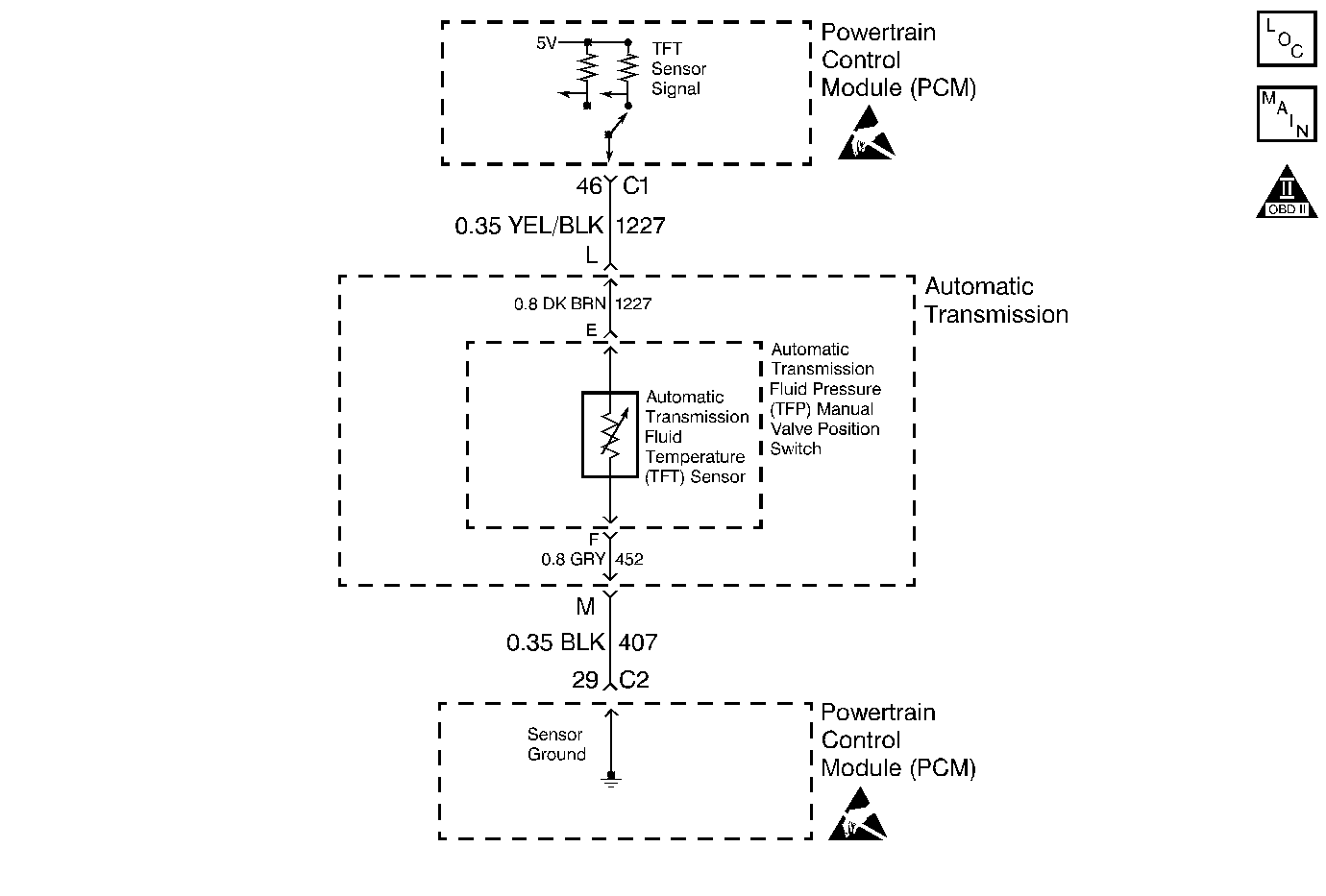
Circuit Description
The Automatic Transmission Fluid Temperature (TFT) sensor is a thermistor. The TFT sensor is part of the Automatic Transmission Fluid Pressure Manual Valve Position Switch (TFP Val. Position Sw.). The Powertrain Control Module (PCM) supplies a 5-volt reference signal to the sensor on circuit 1227. When the transmission fluid is cold, the sensor resistance is high and the PCM senses a high signal voltage. As the transmission fluid warms, the sensor resistance lowers and the PCM senses lower voltage. The PCM uses the TFT reading in order to control the Torque Converter Clutch (TCC), line pressure adjustments, and temperature compensated shifts.
When the PCM detects a continuous short to ground in the TFT circuit or the TFT sensor, then DTC P0712 sets. DTC P0712 is a type D DTC.
Conditions for Setting the DTC
| • | The ignition switch is in the RUN position. |
| • | The TFT voltage is less than 0.33 volts for 10 seconds. |
Action Taken When the DTC Sets
| • | The PCM does not illuminate the Malfunction Indicator Lamp (MIL). |
| • | The PCM freezes shift adapts from being updated. |
| • | The PCM calculates transmission temperature based on engine coolant temperature, intake manifold air temperature, and engine run time. |
| • | DTC P0712 is stored in the PCM history. |
Conditions for Clearing the DTC
| • | A scan tool can clear the DTC from the PCM history. The PCM clears the DTC from the PCM history if the vehicle completes 40 warm-up cycles without a failure reported. |
| • | The PCM cancels the DTC default actions when the fault no longer exists and the ignition is OFF long enough in order to power down the PCM. |
Diagnostic Aids
| • | Inspect the wiring for poor electrical connections at the PCM, the transmission 20-way connector and the TFP Val. Position Sw. 6-way connector for the following conditions: |
| - | A bent terminal |
| - | A backed out terminal |
| - | A damaged terminal |
| - | Poor terminal tension |
| - | A chafed wire |
| - | A broken wire inside the insulation |
| - | Moisture intrusion |
| - | Corrosion |
| • | When diagnosing for an intermittent short or open condition, massage the wiring harness while watching the test equipment for a change. |
| • | Test the TFT sensor at various temperatures in order to evaluate the possibility of a skewed (mis-scaled) sensor. Refer to the Temperature vs Resistance table. A skewed sensor may cause delayed garage shifts or TCC complaints. |
Test Description
The numbers below refer to the step numbers on the diagnostic table.
-
This step tests the PCMs ability to detect an open circuit.
-
This step tests the TFT sensor for correct resistance.
Step | Action | Value(s) | Yes | No | ||||
|---|---|---|---|---|---|---|---|---|
1 | Was the Powertrain On-Board Diagnostic (OBD) System Check performed? | -- | ||||||
2 |
Important: Before clearing the DTCs, use the scan tool in order to record the Failure Records for reference. Using the Clear Info function will erase the stored Failure Records from the PCM. Does the scan tool display a TFT sensor voltage less than specified? | 0.33 V | Go to Diagnostic Aids | |||||
Does the scan tool display a TFT sensor voltage greater than specified? | 4.92 V | |||||||
4 | Inspect circuit 1227 from the engine 20-way connector to the PCM connector for a short to ground. Refer to General Electrical Diagnosis . Did you find and correct the condition? | -- | ||||||
Is the resistance within the range specified for the given transmission temperatures? | 20°C (68°F) 3106-3923 ohms 100°C (212°F) 164-190 ohms | |||||||
6 | Measure the resistance between terminal L and a good ground on the transmission case. Is the resistance less than the specified value? | 1000 ohms | Got to Diagnostic Aids | |||||
7 |
Is the resistance less than the specified value? | 1000 ohms | ||||||
8 | Replace the TFP Val. Position Sw. Refer to the Transmission Unit Repair Manual, 4T40-E Section. Is the replacement complete? | -- | -- | |||||
9 | Replace the automatic transmission wiring harness. Refer to the Transmission Unit Repair Manual, 4T40-E Section. Is the replacement complete? | -- | -- | |||||
10 | Replace the PCM. Refer to PCM Replacement/Programming Is the replacement complete? | -- | -- | |||||
11 | In order to verify your repair, perform the following procedure:
Has the test run and passed? | -- | System OK |
